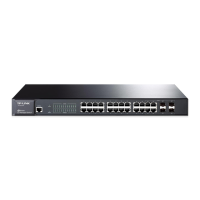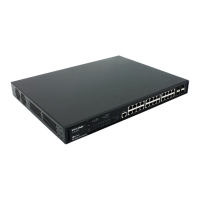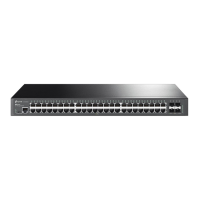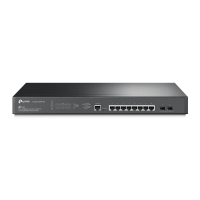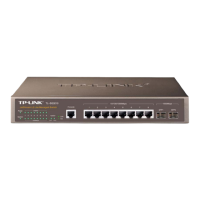Do you have a question about the TP-Link JetStream TL-SL3428 and is the answer not in the manual?
Provides an overview of the guide's structure and conventions, outlining chapter contents.
Introduces the TL-SL3428 switch, its design, features, and capabilities for workgroups.
Details the key features of the switch, including resiliency, layer 2 switching, QoS, security, and manageability.
Describes the physical components of the switch, including front and rear panels and LEDs.
Provides instructions on how to access the switch's configuration utility via a web browser.
Covers basic system properties configuration, including summary, description, time, and IP settings.
Details functions for managing the switch's configuration file, rebooting, and resetting.
Explains security measures for remote login to enhance management security.
Configures basic port features like status, speed, duplex, and flow control.
Covers Link Aggregation Group configuration for creating high-bandwidth paths.
Details the 802.1Q VLAN implementation, tag format, and port link types.
Provides global configuration for spanning trees, including parameters and versions.
Explains IGMP Snooping process and configuration for managing multicast groups.
Details DiffServ configuration for packet classification, priority mapping, and queue scheduling.
Covers rate limiting and storm control features to manage traffic flow and prevent broadcast storms.
Explains ACL configuration, including summary, creation of MAC, Standard-IP, and Extend-IP ACLs.
Details IP-MAC binding to control network access based on host information.
Covers 802.1X authentication for port-based network access control.
Provides global configuration for SNMP, including views, groups, users, and communities.
Explains cluster configuration and management, including roles and topology.
Monitors switch memory and CPU utilization, displaying data graphs.
Provides tools for device diagnostics, including cable tests and loopback tests.
Guides on downloading firmware to the switch using FTP via the bootUtil menu.
Details the steps to configure TCP/IP settings on a PC for network connectivity.
Provides instructions for installing the TP-LINK 802.1X Client Software (TpSupplicant).
Provides an overview of the guide's structure and conventions, outlining chapter contents.
Introduces the TL-SL3428 switch, its design, features, and capabilities for workgroups.
Details the key features of the switch, including resiliency, layer 2 switching, QoS, security, and manageability.
Describes the physical components of the switch, including front and rear panels and LEDs.
Provides instructions on how to access the switch's configuration utility via a web browser.
Covers basic system properties configuration, including summary, description, time, and IP settings.
Details functions for managing the switch's configuration file, rebooting, and resetting.
Explains security measures for remote login to enhance management security.
Configures basic port features like status, speed, duplex, and flow control.
Covers Link Aggregation Group configuration for creating high-bandwidth paths.
Details the 802.1Q VLAN implementation, tag format, and port link types.
Provides global configuration for spanning trees, including parameters and versions.
Explains IGMP Snooping process and configuration for managing multicast groups.
Details DiffServ configuration for packet classification, priority mapping, and queue scheduling.
Covers rate limiting and storm control features to manage traffic flow and prevent broadcast storms.
Explains ACL configuration, including summary, creation of MAC, Standard-IP, and Extend-IP ACLs.
Details IP-MAC binding to control network access based on host information.
Covers 802.1X authentication for port-based network access control.
Provides global configuration for SNMP, including views, groups, users, and communities.
Explains cluster configuration and management, including roles and topology.
Monitors switch memory and CPU utilization, displaying data graphs.
Provides tools for device diagnostics, including cable tests and loopback tests.
Guides on downloading firmware to the switch using FTP via the bootUtil menu.
Details the steps to configure TCP/IP settings on a PC for network connectivity.
Provides instructions for installing the TP-LINK 802.1X Client Software (TpSupplicant).


